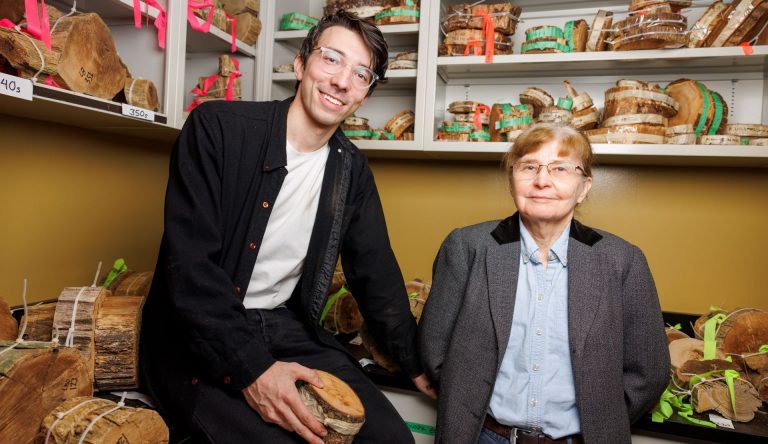Tree rings from Gaspésie mountains reveal effects of global warming dating back almost a century

A study of tree rings in the Gaspésie’s Sainte-Anne River area reveals that snowpacks have been declining noticeably in the region’s mountains for nearly nine decades. The researchers say the phenomenon is directly linked to global warming.
They add that the decline in snowpack in the Parc national de la Gaspésie’s mountains, which form the northern end of the Appalachian Mountain Range, has significant implications for water management and regional wildlife.
The study, led by PhD student Alexandre Pace and Jeannine-Marie St-Jacques, an associate professor in the Department of Geography, Planning and Environment, was published in the Journal of Hydrology: Regional Studies. Concordia PhD student Duane Noel and Guillaume Fortin of the Université de Moncton also contributed.
The researchers created a tree ring record from samples gathered in the mountains, providing data dating back to 1822. This extends the historical knowledge well past the records established from instrumental readings, which only captured data from the mid-20th century.
Tree rings in the region can be a natural indicator of snow melt: thinner rings are associated with springs that have a late-staying snow cover, thicker rings with years of early thaw.
“We found that big, extreme spring melt flows dropped off after 1937, indicating a decline in winter snowpack in the mountains,” St-Jacques says. She adds that the presence of young forests moving upslope is another indicator of longer growing seasons due to reduced snow coverage.
Two centuries of data
The tree ring samples were gathered from 13 sites around the intersection of the Chic-Choc and McGerrigle ranges, in areas that have never been clearcut by the forestry industry. The samples were collected in the summers of 2017, 2018 and 2019 from cedars, spruce and firs, both living and dead. The samples were polished, scanned, digitally measured and crossdated using specialized software to ensure accuracy.
This comprehensive study makes the Sainte-Anne River only the fifth river basin on the entire North American Atlantic seaboard to have its streamflow historically reconstructed based on tree rings. The others are the Hudson, the Potomac, the Delaware and the Santee in South Carolina.
The Sainte-Anne River records collected for this study align with historical streamflow patterns seen in the records of the other four, with synchronous eras of drought and heavy precipitation.
“We can see there are joint patterns of flow, whether it’s at high levels or low,” she says. “As well, if you look at the instrumental records, we see that periods of sustained low flow are about as common as periods of sustained high flow. But if we go back 200 years, we find that periods of low flow are more common, suggesting that water managers should plan for more lower-flow periods, even in this wet area.”
The researchers note that having a broad understanding of how the waterways of the northeastern seaboard interact and share flow patterns can help authorities plan in the case of synchronous droughts in a future of more extreme climate patterns.
Benefits for humans and animals
Tree rings can hold clues that Hydro-Québec relies on to plan major projects. The utility has done several tree ring reconstructions for its La Grande River hydroelectric projects that drain into James Bay and the La Romaine project on the Côte-Nord, emptying into the St. Lawrence Estuary.
But the researchers point out that the Sainte-Anne River data can also be useful in other ways. It can give further insights into the role of declining snow cover in the decline of the Gaspésie caribou population, the only herd of its kind south of the St. Lawrence Estuary. It is also significant for Atlantic salmon, which spawn in rivers but are experiencing significant population threats in the southern parts of their range.
“This project highlights the importance of protecting old growth forests, because that allows us to have these longer tree ring chronologies with which we can reconstruct climate and understand environmental change. They give context to the changes we're seeing today,” Pace concludes.
Funding for this study was provided by grants from the Natural Sciences and Engineering Research Council (NSERC) Discovery Program and the Fonds de recherche du Québec-Nature et technologies (FQRNT).
Read the cited paper: “Filling the Atlantic coastal tree-ring reconstruction gap: A 195-year record of growing season discharge of the Sainte-Anne River, Gaspésie, Québec, Canada.”


